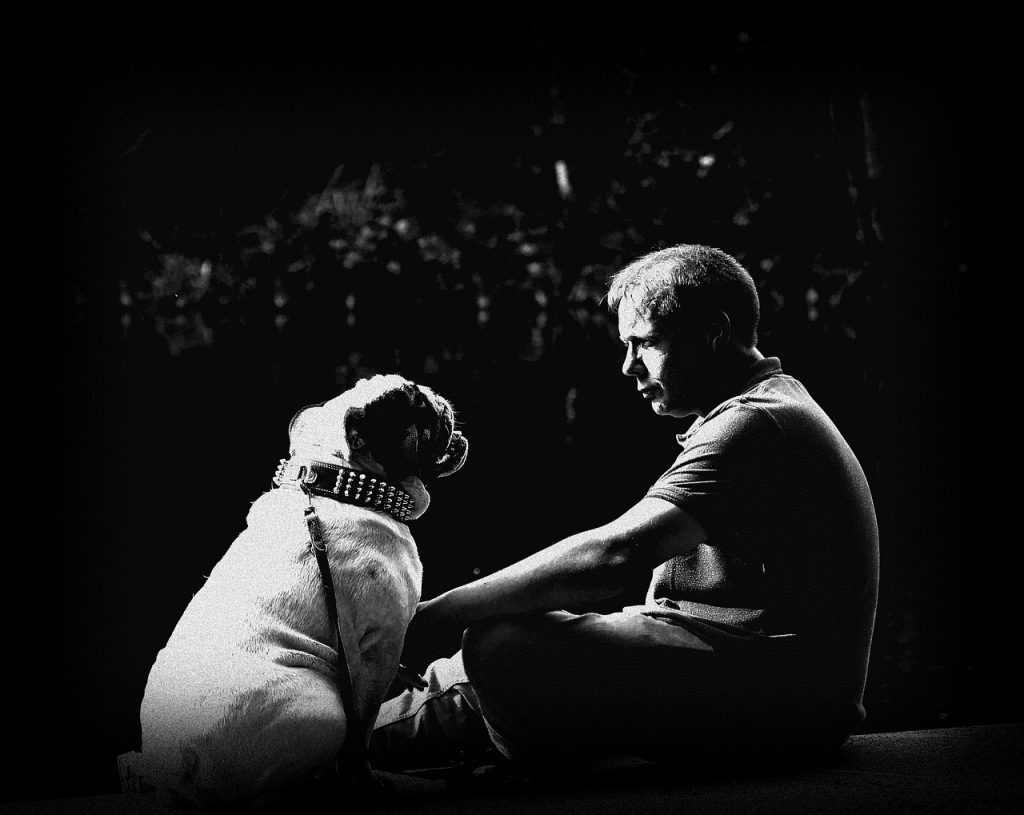The Language Of Barks And Tail Wags: Understanding Canine Communication

Imagine being able to understand what your furry best friend is trying to say through their barks and tail wags. Have you ever wondered if there is a secret language behind these seemingly simple gestures? In this article, we will explore the fascinating world of canine communication, unlocking the hidden meanings behind different types of barks and tail wags. From playful greetings to warning signs, you’ll never look at your dog’s wagging tail the same way again. So, put on your furry detective hat and get ready to decipher the language of barks and tail wags!

Table of Contents
ToggleUnderstanding Canine Communication
Being able to understand and effectively communicate with our canine companions is essential for building a strong bond and ensuring their well-being. Dogs have their own unique language of barks, tail wags, body language, vocalizations, eye contact, sniffing, licking, yawning, and tail positions that they use to communicate with other dogs and with humans. In this article, we will delve into the various aspects of canine communication, explaining the different types of barks, tail wags, body language, vocalizations, eye contact, sniffing, licking, yawning, and tail positions, and what they mean in terms of a dog’s emotions and intentions.
The Importance of Canine Communication
Canine communication serves as a vital tool for dogs to express their emotions, desires, and intentions. It allows them to convey important messages and navigate their social interactions with other dogs and humans. As responsible pet owners, it is our duty to familiarize ourselves with the language of our furry friends to ensure that we can meet their needs and provide them with a safe and comfortable environment.
Types of Canine Communication
Canine communication encompasses a variety of forms, each serving a different purpose and conveying different messages. Let’s explore the different types of canine communication in more detail.
Understanding Barks
Barking is one of the most common forms of vocalization in dogs. It can have a range of meanings depending on the pitch, duration, and intonation. By discerning the different types of barks, we can gain insight into a dog’s emotions and intentions.
Different Types of Barks
Dogs have various types of barks, each serving a different purpose. Some common types of barks include alert barks, playful barks, fearful barks, and aggressive barks. Alert barks are short and sharp, signaling that something has caught the dog’s attention. Playful barks are usually accompanied by a wagging tail and are a way for dogs to express joy and excitement. Fearful barks are often high-pitched and may be accompanied by cowering or trembling. Aggressive barks are deep, loud, and may be accompanied by a stiff posture and a raised hackle.
What Dogs are Trying to Communicate with Barks
When dogs bark, they are trying to communicate various messages. They may be alerting us to a potential threat or intruder, expressing their desire for attention or play, conveying fear or anxiety, or asserting dominance or aggression. It is essential to pay attention to the context and accompanying body language to accurately interpret a dog’s barks.
Interpreting Tail Wags
A dog’s tail wag is often seen as a sign of happiness and friendliness, but tail wags can have various meanings depending on the context and the way a dog holds its tail. Let’s explore the different types of tail wags and their meanings.
Types of Tail Wags
Dogs can wag their tails in different ways, indicating different emotions. A broad, relaxed wag usually signals happiness and contentment. A low and slow wag may indicate uncertainty or caution. A stiff, rapid wag with the tail held high often signifies alertness or dominance. A tucked tail wag, where the tail is held tightly against the body, typically indicates fear or submission.
Meanings of Tail Wags
While tail wags often express positive emotions, such as happiness or excitement, they can also indicate other emotional states. It is crucial to consider the overall body language and the context in which the tail wag occurs. For example, a dog may wag its tail when feeling anxious or fearful, as a way to appease or calm itself. Understanding the different types and meanings of tail wags allows us to better understand a dog’s emotional state and respond appropriately.
Body Language
Dogs communicate a significant amount of information through their body language. Understanding their facial expressions, posture, and movement can provide valuable insights into their emotions and intentions.
Facial Expressions
A dog’s face can convey a wealth of information about its emotional state. By paying attention to their facial expressions, we can better understand their feelings. For example, relaxed facial muscles, soft eyes, and a slightly open mouth usually indicate a calm and content dog. On the other hand, tense facial muscles, narrowed eyes, and bared teeth may signify fear or aggression.
Posture and Movement
A dog’s posture and movement can speak volumes about its intentions and emotions. An upright, confident stance with a relaxed body signals a calm and confident dog. On the contrary, a hunched posture or a lowered body may indicate fear or submission. Paying attention to a dog’s body language can help us gauge their comfort level and respond accordingly.
Vocalizations
Apart from barking, dogs have various other vocalizations that they use to communicate. Let’s explore some of these vocalizations and what they mean.
Growls
Growling is often associated with aggression, but it can also be a means of communication for dogs. Growling can convey a range of emotions, including fear, discomfort, or a warning sign of impending aggression. It is crucial not to ignore or dismiss growling but rather to investigate the underlying cause and address any potential triggers.
Whines and Moans
Whining and moaning are often indicators of various emotions, including anxiety, discomfort, or desire for attention. Dogs may whine or moan when they are separated from their owners, in pain, or seeking reassurance. Understanding the context and accompanying body language can help us determine the underlying reason behind their vocalizations.
Howling
Howling is a form of vocalization that carries across long distances. Dogs may howl to communicate their location, signal their presence to other dogs, express loneliness, or respond to certain sounds, such as sirens. While howling is often associated with wolves, some dogs also possess this instinctual behavior.
Eye Contact
Eye contact plays a significant role in canine communication. Dogs use eye contact to convey various messages and establish social hierarchies. Let’s explore the different meanings of direct eye contact and averted eye contact.
Meanings of Direct Eye Contact
Direct eye contact from a dog can indicate confidence, assertiveness, or a challenge. It may be a way for a dog to establish dominance or assert its authority. However, direct eye contact can also be seen as confrontational or threatening, especially if accompanied by other signs of aggression, such as a stiff posture or bared teeth.
Averting Eye Contact
On the other hand, dogs may avert their gaze to signal submission, fear, or avoidance. Turning their head or looking away can be a way for dogs to diffuse potentially tense situations or show respect to a more dominant individual. Averting eye contact can also indicate trust and a lack of aggression.

Sniffing
Sniffing is a natural behavior for dogs and serves several purposes, including gathering information about their surroundings, identifying scents, and communicating with other dogs. Let’s explore the purpose of sniffing and what it can tell us about a dog’s interest or investigation.
Purpose of Sniffing
Dogs have an incredibly keen sense of smell, and sniffing enables them to gather information about their environment, other animals, and even humans. It allows them to gather essential information about potential threats, food sources, or even social cues. Sniffing also plays a vital role in their communication with other dogs, as scent marking and sniffing one another’s rear ends are common forms of greeting and identification.
Signs of Interest or Investigation
When a dog is interested in something or investigating its surroundings, you may notice a change in their sniffing behavior. They may intensify their sniffing, focusing on a specific object or area. This heightened interest or investigation can indicate curiosity, the search for a certain scent, or a potential threat assessment.
Licking
Dogs use licking as a form of communication for various reasons, including affection, anxiety, and even health concerns. Let’s explore the different meanings behind a dog’s licking behavior.
Affection vs. Anxiety
Licking can be a sign of affection, as dogs often lick their human companions as a way to show love and bond. However, excessive or obsessive licking can also indicate anxiety or stress. Overly anxious or stressed dogs may engage in excessive licking as a self-soothing mechanism. It’s important to pay attention to the context and the intensity of the licking behavior to better understand a dog’s emotions.
Health Concerns
In some cases, excessive licking can be a sign of underlying health concerns, such as allergies, skin irritations, or discomfort. If a dog’s licking behavior becomes excessive or persistent, it is important to consult a veterinarian to rule out any potential health issues.
Yawning
Yawning is another behavior that can communicate various messages in dogs. Let’s explore the signs of stress and the phenomenon of contagious yawning in dogs.
Signs of Stress
While yawning can be a normal behavior for dogs, frequent or excessive yawning can also indicate stress or anxiety. Dogs may yawn when they are in uncomfortable or stressful situations, as it can be a way for them to release tension. It’s essential to pay attention to accompanying signs of stress, such as panting, pacing, or a lowered body posture, to determine the cause behind a dog’s yawning behavior.
Contagious Yawning
Interestingly, dogs can also experience contagious yawning, just like humans. Contagious yawning occurs when a dog yawns in response to seeing another dog or human yawn. It is thought to be a form of empathetic behavior and can be observed in social species like dogs.
Tail Position
A dog’s tail position can provide valuable insights into their emotional state and intentions. Let’s explore the meanings behind a high and stiff tail versus a low and wagging tail.
High and Stiff Tail
When a dog’s tail is held high and stiff, it is often a sign of alertness, dominance, or aggression. A raised tail signifies confidence and assertiveness, while a stiff tail may indicate tension or potential aggression. It is important to approach dogs with a high and stiff tail cautiously, as they may be less receptive to interaction.
Low and Wagging Tail
On the other hand, when a dog’s tail is held low and wagging, it usually indicates friendliness, relaxation, and a non-threatening posture. A loose and wagging tail is a positive sign and often seen as an invitation for social interaction. However, it is important to consider the overall body language and the context in which the tail wag occurs to accurately interpret a dog’s intentions.
In conclusion, understanding canine communication is crucial for responsible pet ownership and building a strong bond with our furry friends. By familiarizing ourselves with the language of barks, tail wags, body language, vocalizations, eye contact, sniffing, licking, yawning, and tail positions, we can better understand a dog’s emotions, needs, and intentions. This knowledge allows us to provide them with the care, attention, and communication they require for a happy and fulfilling life. So next time you interact with a dog, make sure to pay attention to their unique forms of communication and deepen your understanding of their world.